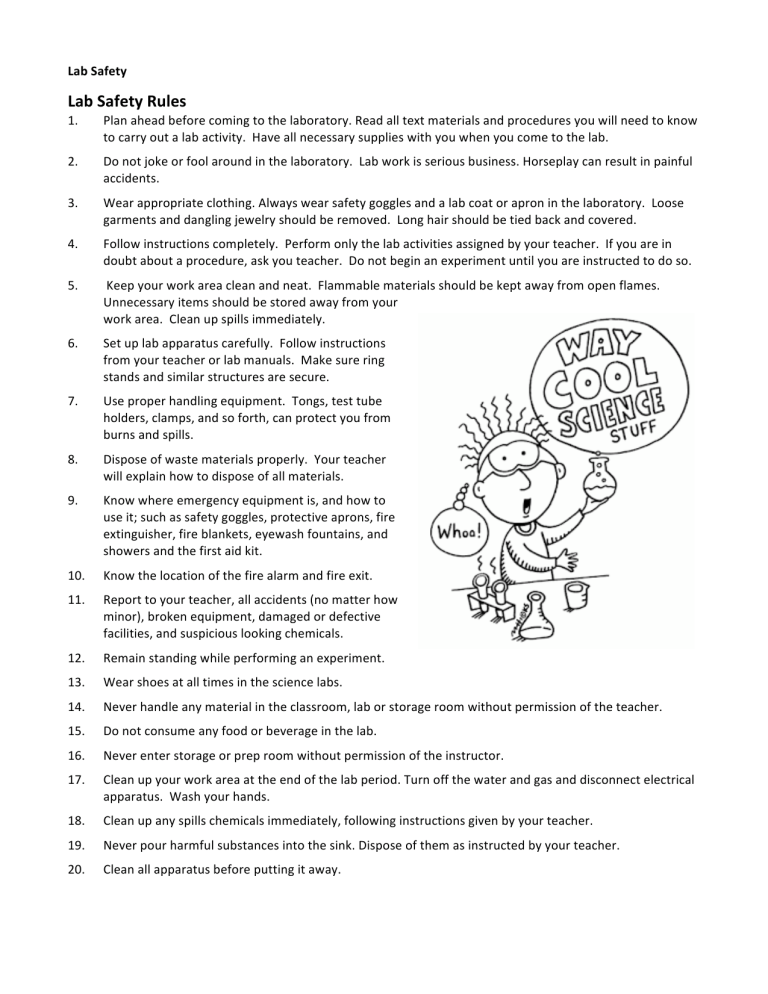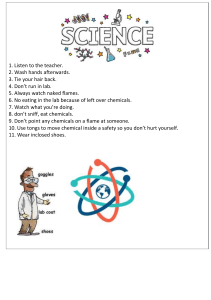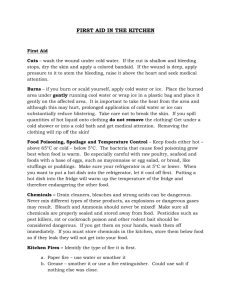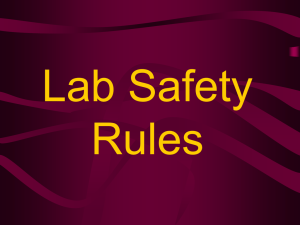
Lab Safety Lab Safety Rules 1. Plan ahead before coming to the laboratory. Read all text materials and procedures you will need to know to carry out a lab activity. Have all necessary supplies with you when you come to the lab. 2. Do not joke or fool around in the laboratory. Lab work is serious business. Horseplay can result in painful accidents. 3. Wear appropriate clothing. Always wear safety goggles and a lab coat or apron in the laboratory. Loose garments and dangling jewelry should be removed. Long hair should be tied back and covered. 4. Follow instructions completely. Perform only the lab activities assigned by your teacher. If you are in doubt about a procedure, ask you teacher. Do not begin an experiment until you are instructed to do so. 5. Keep your work area clean and neat. Flammable materials should be kept away from open flames. Unnecessary items should be stored away from your work area. Clean up spills immediately. 6. Set up lab apparatus carefully. Follow instructions from your teacher or lab manuals. Make sure ring stands and similar structures are secure. 7. Use proper handling equipment. Tongs, test tube holders, clamps, and so forth, can protect you from burns and spills. 8. Dispose of waste materials properly. Your teacher will explain how to dispose of all materials. 9. Know where emergency equipment is, and how to use it; such as safety goggles, protective aprons, fire extinguisher, fire blankets, eyewash fountains, and showers and the first aid kit. 10. Know the location of the fire alarm and fire exit. 11. Report to your teacher, all accidents (no matter how minor), broken equipment, damaged or defective facilities, and suspicious looking chemicals. 12. Remain standing while performing an experiment. 13. Wear shoes at all times in the science labs. 14. Never handle any material in the classroom, lab or storage room without permission of the teacher. 15. Do not consume any food or beverage in the lab. 16. Never enter storage or prep room without permission of the instructor. 17. Clean up your work area at the end of the lab period. Turn off the water and gas and disconnect electrical apparatus. Wash your hands. 18. Clean up any spills chemicals immediately, following instructions given by your teacher. 19. Never pour harmful substances into the sink. Dispose of them as instructed by your teacher. 20. Clean all apparatus before putting it away. Lab Safety Working with Chemicals 1. Check the labels on chemical bottles carefully. Be sure you have the right chemical before taking any. Take only as much as your need. 2. Do not return unused chemicals to chemical bottles. Once a chemical has been removed, it is contaminated and will ruin the rest of the stock. 3. Avoid getting chemicals on your skin and clothing. Hold containers away from your body when transferring reagents. If chemicals do spill on you, wash the area immediately and report the spill to your teacher. 4. If any part of your body comes in contact with a harmful chemical, wash the area immediately and thoroughly with water. If your eyes are affected, do not touch them but wash them immediately and continuously for at least 10 minutes. 5. Never take any chemical or other material from the lab fro any reason 6. Use separate scoopulas for separate chemicals. 7. Add chemical to water, not the reverse. 8. Beware of any liquid or solid on the lab bench (it may be corrosive) 9. Never taste or smell any substance unless instructed to do so by your teacher. Keep your face away from containers hold chemicals. Activities involving poisonous vapours should be performed under an exhaust hood. 10. When you are instructed to smell a chemical in the lab, use the hands waving method only. Never sniff the chemical by placing in close to your nose. If a fire occurs 1. Shut off all gas supplies at the desk valves. 2. Notify your teacher immediately. Since every second is vital, move quickly to provide help in an emergency. 3. Pull the fire alarm. 4. Here are some other recommendation for action a. If clothing is on fire, roll on the floor to smother the flames. Use a fire blanket to smother the flames if a fellow student’s clothing has caught fire. b. A small fire can be smother by using sand or a small container such as an inverted large beaker or can. c. Make sure you know how to operate the fire extinguisher in order to assist your teacher. d. If the fire is not quickly and easily put out, leave the building in a calm manner.


